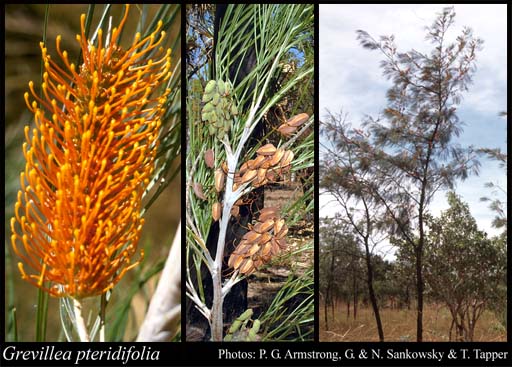- Reference
- Cult.Prot. 121 (1809)
- Conservation Code
- Not threatened
- Naturalised Status
- Native to Western Australia
- Name Status
- Current
Tree or shrub, 4-10(-18) m high. Fl. orange, Apr to Jul or Dec. Yellow sand, sandstone.

Scientific Description
Trees or Shrubs, 2-15 m high; branchlets hairy, with a glaucous bloom or not glaucous. Leaves alternate, 250-450 mm long, hairy, on the abaxial surface, the hairs straight; lamina flat, once divided, pinnately divided, divided to the midrib; lobes 150-250 mm long, 1-10 mm wide, the margins revolute, exposing the lower surface of the leaf blade or enclosing the lower surface of the leaf blade, forming a groove either side of the midvein. Inflorescences axillary or terminal, green, white, orange or grey; pedicels 4-7 mm long. Perianth 7-10 mm long; tepals all free after flower opens, hairy, simple-hairy; ovary hairy, sessile; pistil 25-30 mm long, yellow or orange, pollen presenter oblique, style glabrous. Follicles hairy, not viscid, dehiscent, 14-21 mm long. Flowers in May, June, July, August, September, October, November or December. Occurs in the Northern (N) Botanical Province(s), in the Northern Kimberley (NK), Victoria Bonaparte (VB), Central Kimberley (CK) or Dampierland (DL) IBRA subregion(s).
Distribution
- IBRA Regions
- Central Kimberley, Dampierland, Northern Kimberley, Victoria Bonaparte.
- IBRA Subregions
- Berkeley, Fitzroy Trough, Keep, Mitchell, Pentecost.
- IMCRA Regions
- Kimberley.
- Local Government Areas (LGAs)
- Derby-West Kimberley, Wyndham-East Kimberley.